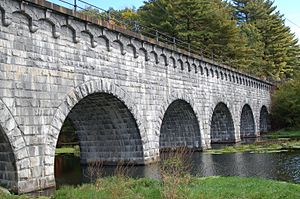Wachusett Aqueduct facts for kids
Quick facts for kids
Wachusett Aqueduct
|
|
|---|---|

Wachusett Aqueduct at Northborough spanning over the Assabet River
|
|
| Begins | Wachusett Reservoir |
| Ends | Marlborough, Massachusetts |
| Official name | Wachusett Aqueduct |
| Maintained by | MWRA |
| Characteristics | |
| Total length | 9 mi (14.5 km) |
| Width | 12 ft (3.7 m) |
| Height | 11 ft (3.4 m) |
| Capacity | 400 cu ft/s (11.33 m3/s) |
| History | |
| Construction start | 1897 |
| Opened | 1905 |
|
Wachusett Aqueduct Linear District
|
|
| Built | 1896 |
| Architect | Frederick P. Stearns |
| MPS | Water Supply System of Metropolitan Boston MPS |
| NRHP reference No. | 89002276 |
| Added to NRHP | January 18, 1990 |
The Wachusett Aqueduct is a special channel that carries water. It moves water from the Wachusett Reservoir to a water treatment plant in Marlborough, Massachusetts. This aqueduct is a key part of the public water system for many towns around Greater Boston. The Massachusetts Water Resources Authority (MWRA) manages it. Think of it as a backup water highway, ready to help if the main one, the Cosgrove Tunnel, isn't available.
Contents
What is the Wachusett Aqueduct?
The Wachusett Aqueduct stretches about 9 miles (14.5 km) long. It starts at the Wachusett Reservoir in Clinton. Then it goes through the towns of Berlin and Northborough. Finally, it reaches the John J. Carroll Water Treatment Plant in Marlborough, Massachusetts.
How was it built?
Most of this water system is underground. About 2 miles (3 km) of it is a tunnel dug through hard rock. The other 7 miles (11 km) is an underground channel. This channel is about 11 feet (3.4 m) high. It has a special horseshoe shape. It's made from concrete, but the bottom part is lined with bricks. While most of it is hidden underground, some parts are above ground.
How is the Aqueduct Used Today?
For a long time, until the 1960s, the Wachusett Aqueduct was the main way water traveled from the Wachusett Reservoir. It used to carry a huge amount of water every day.
A New Main Waterway
In 1965, the Cosgrove Tunnel was built. It became the main way to move water. But in 2003, the Cosgrove Tunnel had to be temporarily closed. This was so a new connection could be made to the MetroWest Water Supply Tunnel. This new tunnel goes east for about 18.6 miles (29.9 km) from Marlborough.
The Aqueduct as a Backup
During that time, the Wachusett Aqueduct became the main water path again. It carried about 240 million gallons (908,000 cubic meters) of water each day! Today, the part of the aqueduct between the Wachusett Reservoir and the treatment plant is a very important backup. If the Cosgrove Tunnel ever needs to be shut down, the Wachusett Aqueduct is ready to step in. There's also an open channel section of the aqueduct. This part can be used in emergencies if there's a big problem with the treatment plant or the main water paths.
A Historic Landmark
Because of its importance and how it was built, the Wachusett Aqueduct and its structures were added to the National Register of Historic Places in 1990. This means it's recognized as a special historical site.
Images for kids




